Phasor
It’s been a non-stop year for Phasor, where the antenna developer has been in the midst of the transformation that will take it to the commercial market.
As the company has focused on its end goal of bringing about seismic change to the global satellite mobile connectivity market, it has been busy reaching key milestones in terms of technical development and the move to commercialization. The enterprise-grade electronically steered antenna is poised to offer a new level of connected experience to passengers and crew on land, sea and in the air.
Technology Development
Phasor has been working with Vicor, a manufacturer of high efficiency power supply systems, and the two companies have developed a new power architecture that enables Phasor to deliver extremely high current at low voltage, thus ensuring robust mobile communications. The power solution provides connectivity speeds and bandwidth previously unachievable while on the move.
__________________________________________
Though 2019 has been a year where milestones have been achieved in preparation to get the product to market, years of hard work have provided a solid foundation for the future
The Factorized Power Architecture™ (FPA) represents a major breakthrough in the delivery of satellite connectivity in aeronautical, maritime, land mobile and defense applications. However, it will also enable the end user traveling on any mode of transportation to enjoy true mobile broadband connectivity, and all the applications that this will enable.
The FPA technology plays an integral role in Phasor’s ESAs and the support of Vicor in the technical innovation of the products helps to differentiate Phasor in what is a very competitive marketplace.
Vicor’s FPA package consists of a Pre-Regulator Module (PRM) and a Voltage Transformation Module (VTM)/Current Multiplier which together deliver the full, regulated, isolated DC-DC converter function. The Voltage Transformation Module (VTM) is a resonant converter and therefore also has very low noise when compared to a hard switched converter.
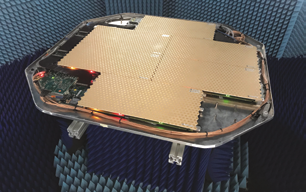
Phasor’s M6 Electronically Steered Antenna (ESA).
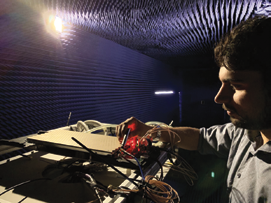
Vital to realizing performance targets in small and large aperture Phasor ESAs is the ability of Vicor’s systems to transform a 48V supply into a 1.5V supply (1V in the next generation of antenna with even higher current).
Phasor’s desire to make this transformation at 65A (or even 80A) represented a major design challenge for powering its application-specific integrated circuits (ASICs). Offering superior power delivery and efficiency than traditional DC/DC converters, Vicor’s approach to transforming voltage eliminates the need for multiple hard-switching converters with several different phases to attain 65A.
Certification
Phasor achieved ISO 9001 Certification ahead of the release of its product range. ISO 9001 is the internationally recognized standard for a quality management system (QMS). This enables companies to operate more effectively on several different levels, including the ability to focus on customer requirements and constantly finding ways in which to improve and become resilient and sustainable.
Why is this significant? It shows Phasor’s evolution from development company towards a process-centric commercial products organization. The processes and procedures that have been implemented and also approved by BSI, will enable better management of the business and will demonstrate to customers that Phasor will support them as they grow.
Preparation for Production
In order to prepare for commercial production, and to be able to scale -up to meet projected demand for its revolutionary ESA system, Phasor created a partnership with industry-leading electronics contract manufacturer Surface Technology International, (STI). STI will bring best-in-class manufacturing capability and will enable Phasor to continue to focus on new technology and product development. In a rapidly expanding market such as mobile broadband, it is important that production is scalable and able to grow with the projected market demand. Therefore, contract manufacturing with a leading partner is a core tenet of Phasor’s strategy.
STI is a specialist Contract Electronics Manufacturer, serving world-class customers in high-reliability industries by providing a complete set of electronics design and manufacturing solutions in both printed circuit board assembly (PCBA) and full box-build manufacturing. The products will be manufactured in the STI Poynton facility, in Cheshire, UK, which is an industry-leading center manufacturing high-quality electronic systems.
Headquartered in Hampshire, UK, and part of the AC Industrials group, STI has decades of experience in the manufacture of complex aerospace, military and satcom systems. This will ensure that Phasor can successfully ramp up production as required with a renowned partner that is located within easy reach of Phasor’s London Technology Center.
Showcasing Capabilities
The Mobile World Congress (MWC19) in Barcelona gave delegates the first glimpse of Phasor’s land mobile Advanced Compact Terminal (ACT) for connected emergency vehicles from partner, HISPASAT.
The satellite operator participated in a demonstrator of a 5G and satellite communications (satcom) connected ambulance at the stand of the Generalitat de Catalunya, showing how future satellite and cellular-based hybrid connectivity will make it easier for emergency medical personnel to receive instructions from specialists in a hospital enabling a full ubiquitous audio-visual connection between the vehicle and the hospital. This will allow the specialist to monitor the patient’s status in real time, which may be key to their survival and subsequent recovery.
An ambulance equipped with Phasor’s Advanced Compact Terminal, will enable the crew to connect via satellite so that the first responder team may use applications such as video teleconference, real-time operational telematics links and high-quality Internet access during the journey to the hospital, regardless of their location or access to terrestrial networks. The ACT including an ESA, which is designed and in-development by Phasor in cooperation with HISPASAT, has full electronic steering and enables mobile connectivity services to be efficiently and reliably offered with high bandwidth.
It was another opportunity to highlight the versatility of the system and its ability to deliver mission critical connectivity, when every second counts.
Our Partnerships
Airbus
Phasor announced a Memorandum of Understanding (MoU) with Airbus through its Network for the Sky (NFTS) program. The two companies are working together to adapt Phasor’s commercial-off-the-shelf (COTS) aeronautical electronically steerable antenna (A-ESA) already in development, for use on Governmental air-transport aircraft and unmanned aerial vehicles (UAVs).
Reliable, resilient aero connectivity that can support the highest data rates is essential to Network Centric operations today to enable a broad range of applications and services.
The Phasor ESA will be capable of supporting high bandwidth data communications with Ku-band satellites in both commercial GEO and LEO orbits and will also include an integrated radome, as a single line replaceable unit (LRU). Delivering as one, NFTS securely and reliably connects airborne assets together with the rest of operations. Operating over a mix of technologies to form one, resilient, high speed global network. NFTS sets the foundation for connected airborne network centric operations.
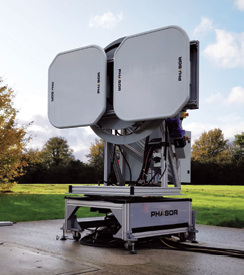
Gogo
Phasor and Gogo also confirmed that their development partnership achieved its initial core-technology performance objectives and will progress to the productization phase. During the next phase, the technology will be packaged as an airborne terminal to address the commercial aviation market.
Gogo identified the promise of Phasor’s innovative solution due to a range of factors, including its multi-constellation capabilities and form factor and sees a number of potential applications for the technology, with initial applicability targeted at smaller commercial aviation aircraft.
Astronics
Astronics Aerosat previewed its next-generation SATCOM connectivity solutions, in conjunction with Phasor at AIX in Hamburg. The new SATCOM inflight connectivity antennas feature electronically steered array (ESA) technology that will deliver unprecedented connection reliability for both civil and military aircraft.
Available in three configurations and with an ultra-low profile, the E-Series will provide Ku- and Ku-HTS connectivity for today’s Geostationary Earth Orbit (GEO) networks, as well as tomorrow’s Medium Earth Orbit (MEO) and Low Earth Orbit (LEO) networks. The system also will offer dual-beam capability, enabling it to support the future “make before break” requirement of non-GEO networks from a single array, or the ability to communicate with two independent GEOs or a LEO & GEO network simultaneously.
Astronics’ E-Series antennas will feature Phasor’s active electronically steered array to provide maximum antenna performance. Unlike competing systems, the E-Series will feature technology that enables a simultaneous transmit and receive from a single antenna array, with no need for bulky extra panels that drive up costly size and weight.
Everywhere On
As Phasor approaches the year of its product launch, it can reflect upon five years of development of a system that will bring fundamental change to on-the-move connectivity.
Though 2019 has been a year where milestones have been achieved in preparation to get the product to market, years of hard work have provided a solid foundation for the future.
The team relishes the challenge of bringing this transformative technology to the people that want and need a completely new and connected experience that is always on, no matter where they go.

As president and CEO of Phasor Inc., David Helfgott has the responsibility for the company’s strategic direction, to drive the development of its new & revolutionary Electronically Steerable Antenna (ESA) products and technology, and to implement its operational programs.
As a 20-year industry veteran, he has extensive experience in satellite broadband, mobile telecommunications and commercial and government SATCOM networking services.
Mr. Helfgott has held leadership positions at Inmarsat, Cobham, DataPath and SES. He holds a BA Degree from the University of Virginia and an MBA from the Darden School.
QuadSAT
2019 has been a big year for both SATCOM and QuadSAT respectively. We’ve seen the first satellites launched into LEO for the planned mega constellations, processes being virtualized within the cloud and plenty of discussion regarding the 5G rollout.
Mega Constellations
We’re entering into an interesting era in SATCOM; during the next few years, we’re expecting the number of orbiting satellites to dramatically increase. With approximately 1,800 currently on-orbit, we could see numbers rise to as many as the tens of thousands of satellites. This increase is sure to raise operational challenges, both on-orbit and at the ground terminal.
LEO is promising more connectivity, something that consumers are expected to fully embrace. The increase in SATCOM use will see RFI management become as important as ever; however, the industry must ensure it is as cost-efficient as possible. The need for SATCOM to be financially competitive must be offset by the need for high quality equipment to deliver reliable coverage.
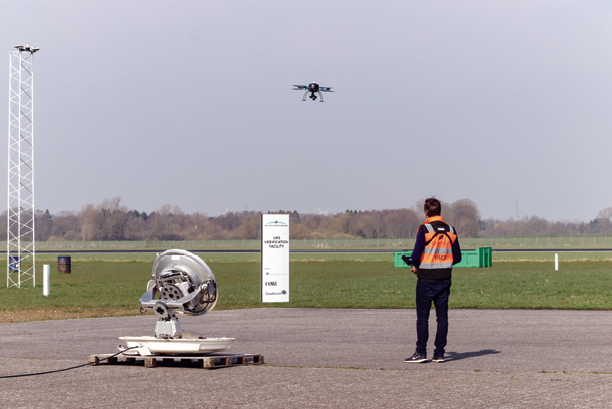
The mega-constellations could potentially open up huge opportunities for the maritime and aviation industries. Offering consumers constant connectivity is appealing. But beyond this,the company anticipates that these industries will be adapting workflows and procedures to incorporate the seamless connectivity that LEO offers. The opportunities are vast — we just need to make sure that we have the tools to deliver the robust connectivity required.
5G has been one of the most talked about aspects of connectivity in 2019. There’s no doubt the discussions around C-band have seen some of the most experienced professionals stop and consider the implications it may have on the industries involved.
The objective is clear; technology must keep improving to manage consumer demands. As always, when using radio frequencies, care must be taken to avoid accidental interference.
__________________________________________
With more and more consumers and industries adopting online applications, we must be sure that the connectivity we are delivering is of the highest quality.
As more operators — and even industries — use RF, managing interference will become increasingly important to ensure that services don’t inadvertently impact upon one another.
Use of the Internet of Things (IoT) is growing quickly. According to a 2019 report by Gartner, the enterprise and automotive IoT market will grow to 5.8 billion endpoints in 2020, a 21 percent increase from 2019. Consumers are turning more and more to the convenience that IoT offers, with building automation, utilities and physical security being some of the more common uses.
IoT is centered around consumers remaining connected with their surroundings, regardless of where they are located. But in addition to consumers adopting the tech, we’re seeing industries employ the technology to improve efficiencies.
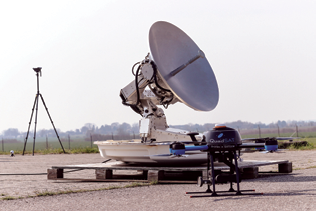
Maritime organizations are turning to IoT to streamline operations and to make data driven decisions that improve efficiencies. The aviation industry is also noting huge benefits in adopting IoT tech. Predictive maintenance, in-flight customer behavioral patterns, in-flight data collection, baggage tracking and flight efficiency are all examples of the role IoT can play in aviation, which is saving airlines time and money.
As always, seamless connectivity is key in delivering these services. The aviation and maritime industries have an obvious need for satellite due to the geographically remote nature of work. This does also highlight the industries’ reliance on SATCOM; there is little room for error in connectivity and reducing the risk of RFI is hugely important.
RFI RF interference is a challenge that has faced the industry since its inception, with human error and poor-quality equipment being some of the most common reasons for RFI incidents. An antenna that is being used daily, especially on a moving vessel, can easily become misaligned and see a break in connectivity.
Testing and calibration must be performed at regular intervals to mitigate RFI, although performing these tests can be costly, technically challenging and inconvenient on an in-service plane or ship. However, antenna testing remains important; we can see efficiencies improving in many industries as a result of improved connectivity.
Drone Tech to Reduce RFI and Increase Efficiency
During 2019, the company completed significant steps forward in reaching business goals. At the start of the year, QuadSAT’s drone tech was in the early stages of development.
In January, QuadSAT secured 700,000 euros in seed funding, led by Vaekstfonden, with participation from Seraphim Capital and additional, existing investors. In addition to the testing and calibration capabilities mentioned above, QuadSAT has always aimed for the product to be used to deliver type approvals, allowing quality testing at the sourcing of equipment.
These investments were critical in developing the prototype for key testing and has allowed us to expand the team, as well as advance our technology. We moved the office to the Hans Christian Andersen Airport in Odense. This has given us useful access to the airfield as well as the great tech community at HCA.
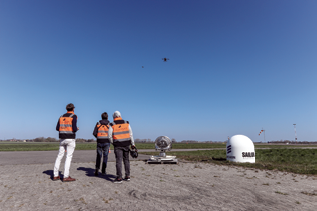
The firm’s drone technology applies a consistent method to determine the performance of new antenna models. All new antennas have to pass through a validation process to ensure that satellite users are sourcing the correct equipment and processes... QuadSAT plays the role as a portable farfield test range, making it location flexible and cost effective. The solution is set to promote consistent calibration and testing procedures of VSAT antennas and, in turn, reduce RFI.
Following months of development, July found the company signing an important contract with ESA, GVF and the Danish Technological Institute to develop the QuadSAT testing solutions to comply with the industry-wide antenna performance SOMAP (Satellite Operators’ Minimum Antenna Performance) requirements, providing our product with certification to deliver compliant type-approvals.
The company’s team traveled to Aflenz in September with SES and Eutelsat for a demonstration of our product and its testing results. We delivered thorough antenna testing on-site using this drone technology, which was witnessed by representatives of both organizations.
The results were sufficient enough for SES to consider adopting QuadSAT`s antenna testing product for future, commercial, antenna qualification activity.
Increasing Connectivity and Minimizing RFI
2019 has undeniably seen many changes within SATCOM; organisations within the industry are adapting to the ever-increasing need for constant connectivity.
However, with LEO, 5G and IoT, companies must be confident in delivering uninterrupted services. RFI is linked to an increase in equipment cost and increase in antenna power levels. To keep SATCOM competitive, it is crucial to keep interferences low.

With more and more consumers and industries adopting online applications, we must be sure that the connectivity we are delivering is of the highest quality. RFI must be both prevented and mitigated to allow seamless connectivity to become a reality.
However, to promote discipline within RF management we must make the tools accessible and cost-effective.
www.quadsat.com
Joakim Espeland is the Chief Executive Officer of QuadSAT.
W.B. Walton Enterprises
2019 has been an exciting year for Walton De-Ice, (W.B. Walton Enterprises, Inc.) as the company marks 40 years of satellite industry experience helping to protect SATCOMS terminals, gateways and teleports from the effects of weather.
In May, our Chairman, William Bartlett Walton Jr., “Bill Walton” was honored with a Lifetime Achievement Award by the World Teleport Association (WTA) for his leadership and contributions to the industry. In announcing the award, WTA noted that “Today, it is hard to imagine the C-band industry delivering reliable services without de-icing. Walton De-Ice has become synonymous with Earth station antenna De-Icing. Bill Walton was there from the beginning, growing with the industry, and building Walton De-Ice over the last four decades.”
Walton De-Ice delivers the most innovative and effective solutions to help protect critical satellite networks from degradation and outages due to weather. The company’s main focus has been keeping Earth station antennas snow and ice-free. The original Walton Hot-Air (Plenum) De-Ice design mounts behind antennas from 3.7 to 32 meters. Walton De-Ice’s energy-saving Snow Shield, Rain Quake, and Ice Quake systems for 0.6 to 6.3 meter antennas,
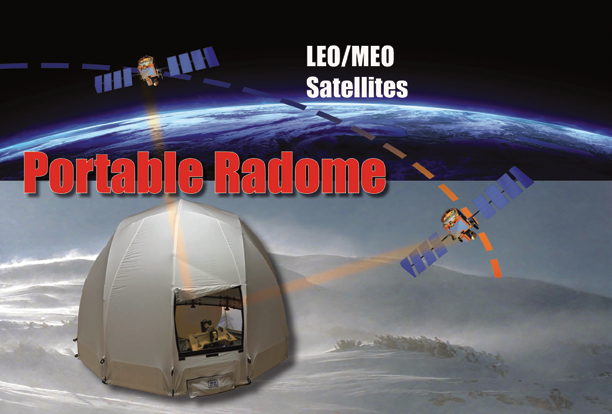
Ka-Band Market Leadership and Growth
Market demand from continued HTS and mobility growth has helped to grow the company’s 2019 business from satellite operators, service providers and integrators this past year as they continue to invest in new Ka-band ground infrastructure. In 2019, we continued to expand Ka-band leadership in the De-Icing field, with many hundreds of Ka-band large antenna systems now successfully deployed. For Earth station antennas from 3.7 to as large as 32 meters, the Walton Plenum Hot Air De-Icing system maximizes pointing accuracy that is so critical for protecting Ka-Band services.
Unlike competing anti-icing solutions, such as electric pad systems that can cause reflector distortion, Walton Hot Air De-Ice systems heat the entire antenna reflector uniformly, which minimizes reflector distortion that can cause signal problems at the Ku- and Ka-bands. Walton systems also uniquely offer maximum flexibility with electric, natural gas and liquid propane gas heater options. Infrared testing of optimal antenna heating distribution offers precision performance validation for the most demanding Ka-Band customer applications.
C-/Ku-Band De-Icing, More Automation, Energy Efficiency in Heating
Customers with C and Ku-band traditional services continued to leverage the firm’s new automation and control features, along with the Ice Quake system, a super-low energy consumption solution for shedding snow off antennas from 0.6 to 6.3 meters.
The Ice Quake can deliver up to 100X energy-savings compared to traditional anti-icing solutions, which is why it has been adopted in teleports as well as cable and broadcast facilities.
In the third quarter of 2019, we also announced that a global sports TV leader had tapped Walton De-Ice to protect its satellite broadcast facilities, joining a Walton De-Ice user community of top operators in SATCOMs around the world.
__________________________________________
Walton De-Ice delivers the most innovative and effective solutions to help protect critical satellite networks from degradation and outages due to weather.
The top global sports media company added Walton’s Hot Air De-Ice and Snow Shield systems to maximize uptime for critical satellite signals at major TV broadcast centers.
New Markets: The Portable Radome
Traditional antenna radomes are not built for transportable operation, yet many of today’s military and first-responder applications on land require deployable systems where harsh elements demand radome-like protection.
Enter the world’s first portable satellite Earth station antenna radome, the Walton Portable Radome, which unleashes a whole new set of possibilities for operating Satellite Transportable Terminals (STT) and micro-VSATs in extreme and mobile conditions to support military requirements for high capacity data, voice and video capabilities worldwide.
It provides a uniquely deployable weather protection solution for applications, such as Military vehicular mount terminals, Comms-On-the-Pause (COTP) or Comms-On-The-Halt (COTH) terminals, VSATs, Transportable uplinks as well as some Enterprise terminals LEO/MEO gateways.
The Walton Portable Radome can protect transportable, trailer and flyaway antennas from high winds, sandstorms, intense heat, snow and ice. Lightweight and airline-shippable for rapid deployment, with easy setup in less than an hour by one person, the Portable Radome goes where no radome has gone before to help live broadcast remotes stay on air.
Complementing protection in harsh winters from snow and ice that the product offers, in burning desert sun heat conditions, an efficient forced air/HVAC system can be added to protect RF and electronics equipment underneath the Radome from overheating damage.
Portable Radome in Remote Broadcast Markets
In September at the IBC 2019 media technology exhibition, Walton showcased the Portable Radome for protecting remote broadcast and sports uplinking applications in extreme weather.
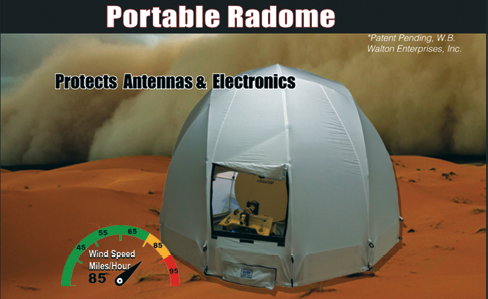
Whether it is for snow at a Winter Olympics, burning sun and dust storms at a Dakar Rally, or heavy winds at a football venue, the Portable Radome protects both on-air signals and satellite equipment from damage.
Portable Radome Traction in Government and Defense Markets
In May, the company announced shipments of the Portable Radome product for U.S. Government and European Defense agency projects. Units were sold for deployment with a U.S. Government agency and a European defense agency in separate customer projects.
We noted then that growing numbers of large government and military contractor customers acknowledged the unique advantages that the Portable Radome can enable for their end-customer’s applications around the world.
New LEO/MEO Design Introduced
In Q3, Walton announced its re-designed Portable Radome for Low Earth Orbit and Medium Earth Orbit (LEO/MEO) satellite Earth station applications, enabling expanded full satellite-arc line-of-sight protection for ground antennas such as LEO gateways and MEO terminals that take advantage of low-latency, high-throughput and next-gen satellite constellations.
The Portable Radome can also be used for fixed site ground networks, and deliver gateway site cost-savings and other advantages
Looking Ahead
Looking to 2020, the company is very excited about opportunities to work with existing and new industry customers, partners, operators and integrators to help deliver the benefits of the firm’s latest technologies into LEO/MEO/GEO infrastructure, DoD programs, 5G Earth station systems, and other missions.
www.de-ice.com
David Walton is Vice President of Walton De-Ice (W.B. Walton Enterprises, Inc.), where he is responsible for the Snow Shield, Ice Quake products and new product development. He has over 37 years of satellite industry experience in the design, manufacture, and deployment of earth station technology, and holds several patents for his inventions in this field. He can be contacted at: david@de-ice.com, or visit.

